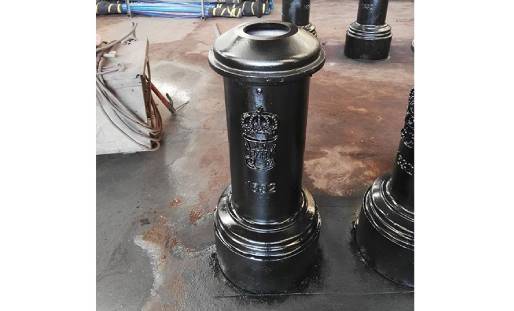3. Normalizing to improve the strength of nodular cast iron
The purpose of ductile iron normalization is to transform the matrix structure into a fine pearlite structure. The process is to reheat the nodular cast iron parts with ferrite and pearlite to 850-900 ℃, the original ferrite and pearlite are converted to austenite, and some spherical graphite is dissolved in austenite. After cooling, the air-cooled austenite is transformed into fine pearlite, so the strength of the OEM ductile iron surface box is improved.
4. Quenching and tempering of ductile cast iron
Ductile cast parts require higher hardness as bearings, and often cast iron parts are quenched and tempered at low temperatures. The process is: the casting is heated to a temperature of 860-900 ° C, and the original matrix is austenitized by heat preservation, and then cooled in oil or molten salt to achieve quenching. After heating and tempering at 250-350 ° C, the original matrix is converted to Fire martensite and retained austenite structure, the shape of the original spherical graphite does not change. The treated casting has high hardness and certain toughness, retains the lubricating performance of graphite, and further improves the wear resistance.
Ductile iron parts as shaft parts, such as the crankshaft and connecting rod of diesel engines, require comprehensive mechanical properties with high strength and good toughness. The cast iron parts are quenched and tempered. The process is: the cast iron is heated to a temperature of 860-900 ° C to keep the matrix austenitized, and then cooled in oil or molten salt to achieve quenching, and then tempered at 500-600 ° C to obtain a tempered sorbate (Generally, there is still a small amount of massive ferrite), the shape of the original spherical graphite does not change. After processing, the strength and toughness are well matched, which is suitable for the working conditions of shaft parts.
5. Isothermal quenching of ductile cast iron
The purpose of isothermal quenching of the ductile iron flower pot is to transform the matrix structure of cast iron parts into a strong lower bainite structure. The strength limit can exceed 1100MPa and the impact toughness AK≥32J. The treatment process is: heating the nodular cast iron parts to a temperature of 830-870 ° C to austenitize the matrix, and then putting it into a molten salt at 280-350 ° C to keep the austenite part into lower bainite. The original nodular graphite does not change. Obtain high strength ductile iron.
The above heat treatment of cast iron shows that the heat treatment of cast iron parts can only change the matrix structure and cannot change the shape and distribution of graphite. The change in mechanical properties is caused by the change of the matrix structure. Graphite flakes of ordinary gray cast iron (including inoculated cast iron) have a great impact on mechanical properties (strength, ductility). Gray cast iron does not significantly improve mechanical properties through heat treatment. It should also be noted that the thermal conductivity of cast iron is inferior to that of steel, and the presence of graphite results in higher notch sensitivity than steel, so the cooling rate (especially quenching) in the heat treatment of cast iron must be strictly controlled.

Ductile Iron Lighting Pole
The purpose of surface heat treatment of cast iron parts is to improve the wear resistance of cast iron parts. Induction heating quenching, laser heating quenching, and soft nitriding in steel are suitable for cast iron. Diesel engines, internal combustion engine cylinder liners are often laser-hardened or soft-nitrided. Laser-heated cast iron has a fast heating speed, and the workpiece can form a hardened layer of high-carbon martensite structure after air cooling, so the wear resistance is greatly enhanced. After the soft-nitriding treatment of cast iron parts, the surface layer forms a high hardening layer of the e-phase compound (Fe2-3N), which not only has high hardness but also has a small coefficient of friction. Therefore, ductile Iron lighting poles have high wear resistance For improvement.
This is the details of the heat treatment of spheroidal graphite cast iron. If you have more questions, you are welcome to come to consult.